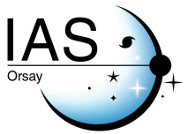A MULTISITE CAMPAIGN TO MEASURE SOLAR-LIKE OSCILLATIONS IN PROCYON. I. OBSERVATIONS, DATA REDUCTION, AND SLOW VARIATIONS
| Titre | A MULTISITE CAMPAIGN TO MEASURE SOLAR-LIKE OSCILLATIONS IN PROCYON. I. OBSERVATIONS, DATA REDUCTION, AND SLOW VARIATIONS |
| Type de publication | Journal Article |
| Year of Publication | 2008 |
| Auteurs | Arentoft, T, Kjeldsen, H, Bedding, TR, Bazot, M, Christensen-Dalsgaard, J, Dall, TH, Karoff, C, Carrier, F, Eggenberger, P, Sosnowska, D, Wittenmyer, RA, Endl, M, Metcalfe, TS, Hekker, S, Reffert, S, Butler, RP, Bruntt, H, Kiss, LL, O'Toole, SJ, Kambe, E, Ando, H, Izumiura, H, Sato, B, Hartmann, M, Hatzes, A, Bouchy, F, Mosser, B, Appourchaux, T, Barban, C, Berthomieu, G, Garcia, RA, Michel, E, Provost, J, Turck-Chieze, S, Martic, M, Lebrun, JC, Schmitt, J, Bertaux, JL, Bonanno, A, Benatti, S, Claudi, RU, Cosentino, R, Leccia, S, Frandsen, S, Brogaard, K, Glowienka, L, Grundahl, F, Stempels, E |
| Journal | Astrophysical Journal |
| Volume | 687 |
| Pagination | 1180-1190 |
| Date Published | Nov |
| ISBN Number | 0004-637X |
| Numéro d'accès | WOS:000260566700031 |
| Résumé | We have carried out a multisite campaign to measure oscillations in the F5 star Procyon A. We obtained high-precision velocity observations over more than three weeks with 11 telescopes, with almost continuous coverage for the central 10 days. This represents the most extensive campaign so far organized on any solar-type oscillator. We describe in detail the methods we used for processing and combining the data. These involved calculating weights for the velocity time series from the measurement uncertainties and adjusting them in order to minimize the noise level of the combined data. The time series of velocities for Procyon shows the clear signature of oscillations, with a plateau of excess power that is centered at 0.9 mHz and is broader than has been seen for other stars. The mean amplitude of the radial modes is 38.1 +/- 1.3 cm s(-1) (2.0 times solar), which is consistent with previous detections from the ground and by the WIRE spacecraft, and also with the upper limit set by the MOST spacecraft. The variation of the amplitude during the observing campaign allows us to estimate the mode lifetime to be 1.5(-0.8)(+1.9) days. We also find a slow variation in the radial velocity of Procyon, with good agreement between different telescopes. These variations are remarkably similar to those seen in the Sun, and we interpret them as being due to rotational modulation from active regions on the stellar surface. The variations appear to have a period of about 10 days, which presumably equals the stellar rotation period or, perhaps, half of it. The amount of power in these slow variations indicates that the fractional area of Procyon covered by active regions is slightly higher than for the Sun. |



